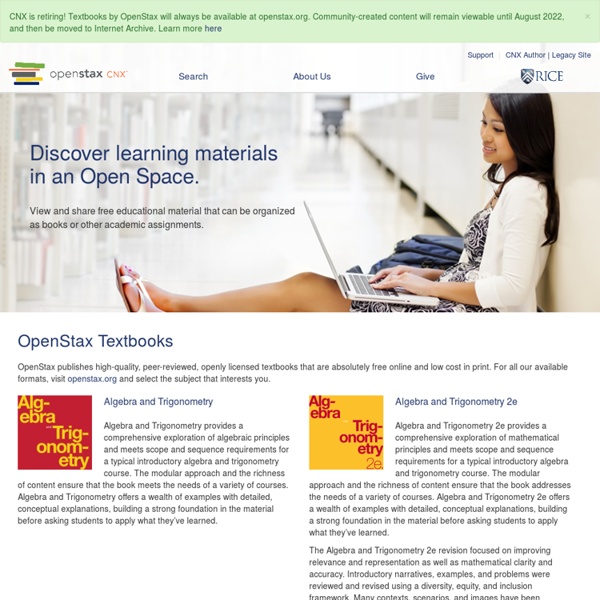



Open Professionals Education Network CC licensed (BY) Flickr photo shared by David Amsler modified by Paul Stacey Reusing existing Open Educational Resources (OER) can save significant time and effort. The OPEN partners recommend TAACCCT grantees invest up-front time finding OER to reuse rather than starting development of new educational resources right away. A significant benefit of OER is that they provide source material to build your development efforts around. No need to invest development effort in creating something that already exists. OER come in a wide variety of types. University of Cambridge Language Centre: Open Courseware - Basic Chinese Overview This is a web-application developed by the University of Cambridge Language Centre for basic level students of Chinese. It focuses on listening and reading skill but it also includes many activities that help learners prepare for speaking and writing. The thirteen sections invite you to acquire the functional language needed to go out and about in town, to travel and to organise your leisure time. It includes Chinese Essentials and a Basic Chinese Grammar.
Euclidea - Apps on Google Play Euclidea is a FUN & CHALLENGING Way to Create Euclidian Constructions! > 127 Levels: from very easy to really hard> 11 Tutorials> 10 Innovative Tools> "Explore" Mode and Hints> Easily Drag, Zoom & Pan> No Advertising! New levels are unlocked as you solve the previous ones. You can complete the whole game only if you earn all the stars. Strengthening democracy through private enterprise and market oriented reform Sparking Debate on Economic Policy in Nepal Samriddhi wins an award at the Asia Liberty Forum in Kuala Lumpur. By Sarita Sapkota, Samriddhi
Elon Musk’s startup eyes human testing for brain-computer interface Elon Musk’s high-profile foray into connecting brains to computers, a 2-year-old company called Neuralink, detailed its ambitions and unveiled some initial results at a livestreamed event yesterday before an invitation-only crowd at the California Academy of Sciences in San Francisco. With thousands watching online, Musk, the entrepreneur behind Tesla and SpaceX, described the firm’s goal of using tiny electrodes implanted in the brain to “cure important diseases” and “achieve a symbiosis with artificial intelligence.” Details about those planned applications remain sparse, but Neuralink briefly presented some of its first rodent data from ultrasmall electrodes at the event.
Open Educational Resources - Babson Survey Research Group Inflection Point: Educational Resources in U.S. Higher Education, 2019 Inflection Point: Educational Resources in U.S. Higher Education, 2019 How to Stay Comfortable on a Long Flight Photo There’s nothing like a 16-hour flight to get you over a fear of flying. At least that was the case for me after my first trip to South Africa to visit the family of the woman who eventually became my wife. At 28, I was still pretty new to flying, and spending the better part of an entire day trapped in an airborne steel tube was just what I needed to stop worrying and learn to love the miracle of air travel. O.K., the truth is, I still don’t love to fly.
Geometry Pad - Apps on Google Play Geometry Pad is a dynamic geometry application for Android tablets with universal appeal. Teachers can use it in a geometry class for better students engagement and deeper understanding of geometric concepts. Students would benefit from using Geometry Pad while working on geometry assignments at home as well. Easily create complex geometric sketches, measure everything you have in your document, experiment with shapes and transformations. Use following tools to sketch your geometry constructions (*): - Move and scale. Scroll the workbook by your finger.
Center for Nanotechnology in Society at Arizona State University (CNS-ASU) The Virtual Institute for Responsible Innovation (VIRI) was created to accelerate the formation of a community of scholars and practitioners who, despite divides in geography and political culture, will create a common concept of responsible innovation for research, training and outreach – and in doing so contribute to the governance of emerging technologies under conditions dominated by high uncertainty, high stakes, and challenging questions of novelty. “Responsible innovation” (RI) is an emerging term in science and innovation policy fields across the globe. Its precise definition has been at the center of numerous meetings, research council decisions, and other activities in recent years. But today there is neither a clear, unified vision of what responsible innovation is, what it requires in order to be effective, nor what it can accomplish. Representatives from VIRI Network Member Institutions, Summer Meeting 2015 Mission
Connexions is: a place to view and share educational material made of small knowledge chunks called modules that can be organized as courses, books, reports, etc. Anyone may view or contribute: authors create and collaborate instructors rapidly build and share custom collections learners find and explore content by yummyur Jun 9